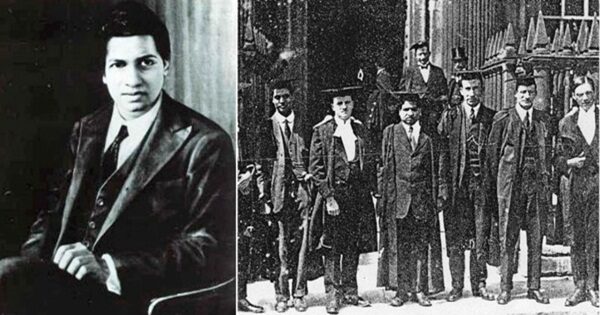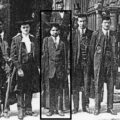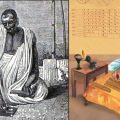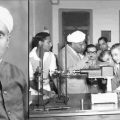Srinivas Ramanujan: Indian Mathematician who defined Infinity; An Analysis

Ramanujan’s story, the man who knew infinity, is a mix of both a fairy tale and a tragedy. A fairy tale, as it talks of a poor Tamil youngster, though failed to obtain a degree, got elected as a fellow of Trinity College, Cambridge. The tragedy lies that he died at the age of 32, a victim of tuberculosis.
Early Days
Srinivas Ramanujan Iyengar was born in Erode, about 400 km from Chennai on the 22nd of December, 1887. His parents Srinivas Iyengar and Komalathammal lived in Sarangapani Street in Kumbakonam, a temple town in Tamil Nadu. At the age of 2, he shifted with his mother to Kanchipuram, a temple town where his mother’s parents lived. He had two brothers, Lakshmi Narasimhan, born when Ramanujan was ten and Tirunarayan, born when he was seventeen.
The family later returned to Kumbakonam. The city was the capital of the ancient Chola empire. Kumbakonam was a major town, the sixth-largest in the Madras presidency. At the time when Ramanujan was growing up, Kumbakonam had a higher proportion of professionals than any other town in the presidency, except Madras. Kumbakonam is also famous for its Silk Sarees, dazzling in bright colours. It cost as much as Rs. 100 – a year’s earnings for many poor families those days.
Ramanujan’s father Srinivasa Iyengar was a clerk in a saree shop, earning about Rs. 20 per month. Ramanujan’s mother sang Bhajans at a nearby temple earning five-ten rupees. At the age of two, Ramanujan suffered from smallpox. He carried pockmarks throughout his life. During this period, pox claimed thousands of lives. From an early age, Ramanujan was sensitive, stubborn and self-willed. He would do stuff only of his free will, or not at all. He was a young boy, who asked questions. He had no much interest in sports or outdoor activities and his parents too discouraged him from going outside to play. So, he was a boy who was mostly by himself, occasionally talking to friends from the window that overlooked the street.
Srinivas Ramanujan was enrolled at Kangeyan primary school. After his paternal grandfather died, he shifted to Madras where his maternal grandparents now lived. Ramanujan returned to Kumbakonam after six months at Madras. He refused to enrol in school, during his stay in Madras.
At Kumbakonam, he was re-enrolled in the Kangeyan primary school. Ramanujan’s father was the primary bread earner of the family because of which he hardly spent time at home. He worked long hours in the shop. His mother was the key figure in his young life. She influenced Ramanujan’s ideas, views and outlook. From his mother, Ramanujan learnt all the traditions and principles of Brahmanical traditions and the Puranas.
There was the huge Sarangapani temple, close to his house, adorned with beautiful sculptures. He spent a lot of his time in the temple. He came to the temple with his family very often, especially during festivities or auspicious days. He virtually grew up in the shadow of the temple.
At the age of 5, Ramanujan’s family performed the ‘Upayanayam’ ceremony for him. The same lasted for four days and invested him with the sacred thread. Throughout his life, he led the life of a traditional Brahmin (in terms of practices). Ramanujan prayed to the family deity, the goddess Namagiri of Namakkal. He always thought his actions were the reflections of her wishes. He was well versed in Vedas, Upanishads, and other Hindu scriptures. He attributed his ability to grasp mathematical texts in foreign languages to the gods. From an early age, Ramanujan recited passages from the Vedas, Sastras and Sanskrit scriptures and elucidated their meanings with ease.
Ramanujan’s parents knew only Tamil. But, English was an important language during this period. Ramanujan studied English from an early age and in 1897, he passed his primary examinations in English, Tamil, Arithmetic and Geography. He scored the highest marks in the district. The following January, he joined the Town High School.
The school was about a five-minute walk from Ramanujan’s house. During his stay in this school, people began to notice his special gifts. Classmates rushed to him with mathematical problems. While in the eighth standard, he was challenging the teachers. One day, the mathematical teacher pointed out that anything divided by itself was one. ‘Divide three fruits among three people, each will get one…’ Ramanujan asked immediately, ‘But is zero divided by zero also one? If no fruits are divided among no one, will each still get one?’
Ramanujan’s family condition to be precise was economical, and they always looked out for extra income. When he was 11, two boys studying at the nearby government college came to stay with them as paying guests. Witnessing Ramanujan’s interest, they shared with him whatever they knew. Within months, he had been exhausted with the knowledge shared and pestered them for more books from the college library.
One of these was an 1893 English textbook on Advanced trigonometry by S.L. Loney. At the age of 13, he had mastered it. He learnt to solve cubic equations from an older boy. His seniors used to share problems that they thought were difficult. Every time there was utter amazement, as he solved them instantly. His teachers and fellow students were in awe of him.
He won several merit certificates and scholastic prizes. At a prize-giving function, his headmaster introduced him to the audience as a student who deserved more than 100 marks. Ramanujan was a prodigy by now.
The Struggle Days
During school, Srinivas Ramanujan came across a book, a synopsis of elementary results in pure and applied mathematics by George Shoobridge Carr. It had roughly about 5000 equations in algebra, calculus, trigonometry and analytic geometry with abridged demonstrations of the propositions.
This book had an immense impact on him and his love for mathematics. Ramanujan decided to solve all the problems in Carr’s book. In the process of proving one formula, he discovered many other equations and as a result, he began to compile his original work in a notebook. Between 1903-14, he completed three notebooks.
After finishing High School, Ramanujan joined Kumbakonam’s government college on scholarship. He was immersed in mathematics and lost all interest in every other subject. He ignored Physiology, English, Greek and Roman History. Due to this ignorance, he failed in English composition and his scholarship was taken away from him. The scholarship was a necessity, as Ramanujan belonged from a poor account.
Unable to find a solution, he ran away from home in August 1905, at the age of seventeen. He set Visakhapatnam as his destination, more than 500 miles from Kumbakonam. His parents, worried, advertised in the newspapers. His father searched for him in Madras and Tiruchirapalli. By September, he was back with his family.
After a year’s failure in Kumbakonam, Ramanujan decided to give it another try in Madras. As followed, Ramanujan arrived at Egmore railway station to join Pachaiyappa. In 1906, Pachaiyappa’s college was regarded as a respectable educational institution in Madras, open only to Hindus. Exhausted by Journey, he fell asleep in the waiting room of the station. A man woke him up, took him to his house, fed him and directed him to the college.
Ramanujan, eighteen by now, aimed to be a degree holder. His mathematics teacher was so impressed by his notebook, suggested the principal give Ramanujan a partial scholarship.
“When the master solved a problem in algebra or trigonometry using a dozen mathematical steps, Ramanujan would solve it in three or four steps.”
He often worked out the key steps in his head, leaving his classmates and teachers both astounded and confused. Sometimes, he worked with the college’s senior mathematical professor, P. Singaravelu Muthaliar, who was impressed by Ramanujan’s brilliance. Together, they solved problems that appeared in mathematical journals.
Ramanujan’s financial conditions were precarious. He found it difficult to meet both ends. One day, the wind blew his cap as he boarded the electric train. His classmates pooled money together to buy a new cap for Ramanujan, as his Sanskrit teacher was strict that the boys covered their traditional tufts with caps only.
Unfortunately for Ramanujan, his experience at Kumbakonam repeated here itself. If English was a hurdle at Kumbakonam, it was Physiology in Madras. He never liked the idea of cutting up frogs, being a strict vegetarian. During an examination on the digestive system, he scribbled a few lines on the answer sheet and submitted unsigned. ‘Sir, this is my undigested product of the Digestion chapter’. The professor had no difficulty in identifying who’s paper it was.
He performed poorly in all the subjects, except for mathematics. “Everyone knew he was gifted, but that was not enough to get him a degree.” The system had no place for an eccentric genius like him. So without a degree or a job, Ramanujan languished at home in Kumbakonam. Srinivas Iyengar’s income of Rs. 20 per month was not enough. Ramanujan went without food at times. On days, an old woman in the neighbourhood would feed him.
To earn some money, Srinivas Ramanujan decided to tutor students. The trouble was that he taught one method on a particular day, and, if the student forgot this method, he would teach a new method the next day. He also posed complicated questions, which the students found difficult to understand. He would often puzzle students by philosophical observations.
Here and There
Ramanujan’s academic failures enabled him to develop unconventional methods, he was left undisturbed to pursue mathematics. He received no guidance, no stimulation, just a few rupees from tutoring. Neither Ramanujan’s family nor his friends discouraged him or demanded that he must find work. They knew and loved the man with an open heart.
“To Ramanujan, mathematics was closely connected to his faith, his belief in the goddess Namagiri. Later, when he went to England, he would build a theory of reality around zero and infinity, though his friends were at a loss to know what he meant by it. Zero, According to him, represented absolute reality. Infinity was the myriad forms of that reality.”
For Ramanujan, numbers and their mathematical relationships showed how the universe fits together. He found spiritual meaning in mathematics. He said ‘An equation for me has no meaning unless it expresses a thought of God.’
Ramanujan Married Janaki, then nine years old. Janaki was simple and pretty. She was to join Ramanujan only after three years. So outwardly, nothing changed in his life after marriage.
The Madras Chapter
At Madras, Ramanujan stayed at the Victoria students hostel with Viswanatha Sastri whom he had tutored. Every morning, Ramanujan would set out in search of students to tutor. He did not succeed because unfortunately, the news of his complicated methods of teaching preceded him. Ramanujan was upset. He was consoled by Viswanatha Sastri who trusted the innate genius of Ramanujan and firmly believed that Ramanujan would get recognition in due course. Ramanujan replied in a sad state of mind that a great man like Galileo had died misunderstood and under house arrest. It would be his turn to die in poverty.
Ramanujan’s only were two large notebooks stuffed with mathematics. Ramanujan had only his notebooks to claim as proof as a reflection of his work. In a structure, where wealth and academic degrees commanded respect, Ramanujan’s wealth was his notebooks.
Srinivas Ramanujan was a simple man with simple needs and manners. He was Hardworking and persistent but failed to acquire a job. He went knocking on doors, with recommendation letters from professors and other senior people.
He met V. Ramaswami who had founded the Indian Mathematical Society. Ramaswami recommended that he met P.V. Seshu Iyer, a charter member of the mathematical society. However, nothing came of it. In December 1910, Ramanujan went to meet R.Ramachandra Rao, who was the district collector of Nellore. His contemporary and friend, C.V. Rajagopalachari, assured Ramachandra Rao of Ramanujan’s ability. Though he could not give Ramanujan a job, he promised to pay him an allowance of Rs. 25. It was not much but freed Ramanujan from Economic worries.
Ramanuja’s first paper appeared in the journal of the Indian Mathematical Society, in 1911. Ramanujan came into the limelight both at home and abroad. In the mathematical society journal, he published interesting problems, one after another. Due to his unemployed condition, he lacked enough money to buy paper. He required four reams of paper a month. For lack of paper, he sometimes wrote in Red Ink on paper already written upon.
Ramanujan’s first stint at the Madras Accountant General’s office for Rs. 20 per month lasted only a few weeks. Thereafter, under the guidance of Ramachandra Rao, he applied for a job at the Madras port trust. He was appointed as a clerk in the accounts section, for Rs. 30 per month. He was appointed On 1st March 1912, precisely three weeks after he applied for the job, He worked under sir Francis Spring and S. Narayana Iyer.
Now that he had a steady income, his wife Janaki, along with Ramanujan’s mother came to stay with him.
Ramanujan, worked upon his mathematical equations and various theorems before he left for the office and again after he came home. On days, his zeal persisted till six the next morning, grabbing two or three hours of sleep before rushing to work. He indulged in mathematics, even in the office, after completing his allotted quota of work.
Narayana Iyer, who was a member of the Mathematical Society, had a great fondness for Ramanujan. In the evenings, both would go to the elder’s house on Pycrofts Road in Triplicane. There, sitting on the porch, they solved mathematical problems on their slates till midnight. Narayana Iyer was a good mathematician. Nevertheless, Ramanujan’s habit of collapsing many steps left Narayana dazed. Many times, Narayana Iyer said ‘Descend to my level of understanding and write at least ten steps between the two steps of Yours.’ ‘Why? wasn’t it obvious?’ That would be Ramanujan’s answer.
Narayana Iyer convinced sir Francis Spring that Srinivas Ramanujan was an innate genius, a remarkable mathematician. The Britisher too realised that Ramanujan was someone special, but how special and gifted, they were not sure. His friends and well-wishers advised him to write to Cambridge or elsewhere in the west for help since no one in India understood him. Ramanujan seeking advice or help wrote to H.F. Baker, a great mathematician, but the same was politely turned down. This was followed by another letter to E.W. Hobson, an equally distinguished mathematician, but the same was turned down too.
On 16 January 1913, Ramanujan wrote to another Cambridge mathematician, G H Hardy, who at thirty-five, was already well known as a brilliant mathematician. The letter began as follows:
Dear Sir,
I beg to introduce myself to you as a clerk in the Accounts Department of the Port Trust Office at Madras on a salary of only 20 pounds per annum. I am now about 23 years of age. I have had no University education but I have undergone the ordinary school course. After leaving school I have been employing the spare time at my disposal to work in Mathematics. I have not trodden through the conventional regular course which is followed in a University course, but I am striking out a new path for myself. I have made a special investigation of divergent series in general and the results I get are termed by the local mathematicians as “startling”.
The concluding paragraph read:
I would request you to go through the enclosed papers. Being poor, if you are convinced that there is anything of value I would like to have my theorems published. I have not given the actual investigations nor the expressions that I get but I have indicated the lines on which I proceed. Being inexperienced I would very highly value any advice you give me. Requesting to be excused for the trouble I give you.
I remain,
Dear Sir,
Yours truly,
S Ramanujan.
Road to Cambridge
Ramanujan’s name will always be linked with Godfrey Harold Hardy. Hardy, both as an individual and as a distinguished mathematician, understood the magnitude and effect of Ramanujan’s work that was to bring a turnaround in Ramanujan’s career. Ramanujan’s letter to Hardy consisted of eleven pages, written in large, legible, rounded school-boy script. The letter was filled with theorems of the Divergent series. When Hardy first read the letter, he must have had thought that Srinivas Ramanujan was just an Indian crank. So, the manuscripts were aside and Hardy engrossed himself in his daily tasks. During the evening, he probed through Ramanujan’s theorems and was baffled.
Hardy was indisputably one ‘s of England’s finest mathematicians. A product of the best education system that existed during that period and in practice with the latest mathematical thought, was astounded by Ramanujan’s theorems. Hardy, like the Indian mathematicians, was reluctant and unable to comprehend what to make of his work. He must have doubted his fine judgment of it, and consulted his colleague, another great mathematician, John Edensor Littlewood. Both probed the theorems before them and decided that there was much more in Ramanujan’s formulae than met the eye. The theorems left Hardy and Littlewood dazzled, as they dig further. Hardy would rank Ramanujan’s letter as ‘certainly the most remarkable letter I have ever received…its author, a mathematician of the highest quality, a man of altogether exceptional originality and power.’
Hardy’s reply was full of appreciation and encouragement, but he particularly demanded to see proofs of the theorems. Hardy wrote ‘I particularly want to see your proof of your assertions here. You will understand that, in this theory, everything depends on the rigorous exactitude of proof.’
Hardy felt it would be best if Ramanujan came to Cambridge. A Brahmin travelling to Europe or America, in those days, was accused of going against his faith. It meant exclusion from caste. That implied friends would exclude you from all rituals and functions. You were not allowed to enter temples or get any help for the funeral of a family member.
Ramanujan was from a very orthodox Brahmin family and at the outset, he was not willing to go to Cambridge.
Gilbert Walker, a former mathematical lecturer at Trinity College, Cambridge, was surprised and expressed amazement at Ramanujan’s work. He endorsed Hardy’s idea urging the young man to spend time at Cambridge. Walker’s endorsement had an immediate effect. B. Hanumantha Rao, who was a mathematics professor at an engineering college, invited Narayana Iyer (Ramanujan Colleague) to a meeting of the Board of Studies in Mathematics to create new ways for Ramanujan. Ramanujan was granted a monthly research scholarship of 75 rupees by the board for the next two years at the University of Madras.
The scholarship granted by 12th April, set Ramanujan free to pursue mathematics, to attend lectures at the university and use its library.
Srinivas Ramanujan, the special research student, was a hot topic in Madras. Everyone wondered how he attained such an intellectual position without the help of books or teachers.
Hardy sent three letters to Ramanujan asking for rigorous proofs for his theorems. Ramanujan, however, held back, offering excuses. Finally, Hardy requested Eric Harold Neville, his colleague and friend who was visiting Madras for lectures, to somehow persuade Ramanujan to visit Cambridge. Neville and Ramanujan struck a bond instantly and just after three meetings, Ramanujan asked Neville whether he would like to take the notebooks to study at leisure. Neville considered this as a great compliment as the priceless Notebooks had never been out of Ramanujan’s hands. Neville had won his trust. Neville urged Ramanujan to come to Cambridge and, to his surprise, Ramanujan agreed.
‘Ramanujan always said that he had been divinely inspired to go to Cambridge.’
Once the decision was made, Neville set Ramanujan’s fear to rest. Firstly, his travel and living expenses would be taken care of. His English was good enough for him to manage at Cambridge. His preference for Vegetarian food was respected. Ramanujan could not bear the thought of writing any examinations. Neville assured him that he would not have to.
However, all was not well on the family front. Ramanujan was a point of consideration. His family was worried and reluctant, as they might have had thought, that English cold may prove futile to Ramanujan’s indifferent health. Further, Srinivas Ramanujan was a strict vegetarian. Many of his friends saw it as an attempt to transfer to the English University the glory and fame that belonged to Madras. Neville’s instinct told him otherwise. He was convinced that Trinity served a higher purpose in Ramanujan’s life. It would help Ramanujan to reach the zenith of glory. Neville’s conviction convinced (though with many reluctant thoughts) Ramanujan’s friends, and especially his family. Due to the sincere efforts of Hardy and Neville, a scholarship was granted to Ramanujan to leave for England.
His Friends coached him in western ways. His ‘Kutumi’ had to go. He had to wear western clothes. He was taught to use a fork and knife. However, all this did not excite Ramanujan. He was worried about how he would stay vegetarian in England. He hated his western haircut. He felt uncomfortable with the clothes he had to wear.
What was in store for him in England?
On the morning of his departure, an official send-off was held in his honour, organised by Srinivas Iyengar, the advocate-general.
Narayana Iyer had a strange request at that time. He asked whether he could exchange slates with Ramanujan. He hoped that he would get inspiration from the slate during Ramanujan’s absence.
Srinivas Ramanujan was in tears. He had dispatched his family to Kumbakonam. His life had taken a sudden turn. He had been an unknown boy sitting alone on the pial of his house in Kumbakonam. Now the elite of Madras had turned out to see him off. He was a dropout from a government college. Now, he is bound for Trinity College, Cambridge. He had struggled to obtain three rupees to go to Madras from his village. Now, he was taking a four hundred rupee fare journey to England.
His friends knew that he was unhappy. He was going as if obeying a call.
The British-India Lines S.S.Nevasa was to take him to England. Ramanujan was introduced to the captain and the passengers. Among them was Dr Muthu, a tuberculosis specialist. There was good cheer and light banter.
At about 10 am on 17th March 1914, the Nevasa slipped slowly away from the dock, with Srinivas Ramanujan on board. Over the days, he began to enjoy the voyage. He mingled with the passengers and ate vegetarian food. He sent letters to friends in India and, on 14th April, the Nevasa arrived at the mouth of the Thames.
References:
1. Hans Eysenck (1995). Genius Cambridge University Press
2. Hardy, Godfrey Harold (1940). Ramanujan: Twelve Lectures on Subjects Suggested by His Life and Work. Cambridge University Press.
3. Kanigel, Robert (2016). The Man Who Knew Infinity: A Life of the Genius Ramanujan. Simon & Schuster.
4. Krishnamachari, Suganthi (27 June 2013). “Travails of a Genius”. The Hindu.
My sincere thanks to Bandana Singh Bose to help me with the research and ideas for the write-up.
(Note – This is the first article in the series of two on Srinivas Ramanujan. It covers Ramanujan’s journey to Cambridge. The second article would cover his successful stay in Cambridge and his works).
Featured image source: The Vintage News.






